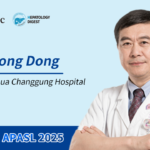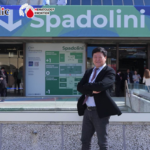
On March 30, the city of Florence—birthplace of the Renaissance—welcomed the grand opening of the 51st Annual Meeting of the European Society for Blood and Marrow Transplantation (EBMT 2025). As one of the most influential global events in the field of hematology, this year’s congress gathered more than 5,000 experts and scholars from around the world to explore the latest advancements in hematopoietic stem cell transplantation and cellular therapies.At this prestigious meeting, the team led by Professor Jia Wei from Tongji Hospital, Tongji Medical College, Huazhong University of Science and Technology, presented three innovative studies (Abstracts A082, A093, and A134). These works shed light on the synergistic role of autologous stem cell transplantation (ASCT) and CAR-T cell therapy, and their potential for clinical translation.During the congress, Hematology Frontier had the opportunity to interview Professor Wei, who provided in-depth insights into the sequential integration of ASCT and CAR-T therapy, particularly its innovative potential to overcome high-risk factors such as TP53 mutations. The discussion also delved into key scientific issues such as optimization of dual-target CAR-T constructs, improvement in treatment safety, and enhancing the universality of therapeutic strategies.Hematology Frontier: At this year’s EBMT Congress, your team presented three studies related to CAR-T therapy (A093, A134, A082). Among them, Study A093 showed that combining ASCT significantly improves long-term survival in patients with TP53 mutations, while Study A082 also demonstrated higher CR rates in the ASCT-combination group. What mechanisms do you believe underpin the synergy between ASCT and CAR-T? For which patient populations might this combination strategy potentially reverse poor prognosis?
Prof. Jia Wei: In recent years, Tongji Hospital of Huazhong University of Science and Technology has conducted an innovative clinical study exploring the sequential application of autologous hematopoietic stem cell transplantation (ASCT) and CAR-T cell therapy in the treatment of relapsed/refractory B-cell lymphoma. At this year’s EBMT meeting, we reported 6-year long-term follow-up data demonstrating that this sequential approach can effectively overcome high-risk adverse prognostic factors, including TP53 mutations.
Mechanistically, the synergistic effect operates on multiple levels. First, the optimized conditioning regimen prior to CAR-T infusion reshapes the in vivo immune microenvironment, creating a more favorable niche for CAR-T cell expansion. Second, ASCT significantly reduces the proportion of immunosuppressive components within the tumor microenvironment, thereby reversing immune suppression. This enhances the specific cytotoxicity of CAR-T cells and extends their in vivo immune surveillance capacity.
Our data show that this combination strategy is not only applicable to CD19/CD22 dual-target CAR-T therapy but has also yielded comparable efficacy in sequential transplantation strategies involving novel CAR-T targets. These findings suggest that the ASCT-CAR-T paradigm may have broad applicability and clinical translational potential, offering a new treatment option for high-risk hematologic malignancies.
Hematology Frontier: In your view, what are the current bottlenecks in CAR-T therapy for B-cell malignancies? Based on your team’s three studies—spanning dual-target CAR-T constructs, ASCT combinations, and supportive care optimization—what areas will your future research focus on?
Prof. Jia Wei: In the treatment of B-cell lymphomas, dual-target CAR-T therapy has become a widely adopted strategy to combat antigen escape, particularly CD19-negative relapse. However, based on clinical data from our center and others, existing dual-target platforms only partially address the challenge of antigen escape. There remains significant room to improve complete response (CR) rates, overall response rates (ORR), and overall survival (OS).
Future directions should focus on structural optimization of dual-target constructs, such as the development of fourth-generation CAR-T technologies aimed at enhancing the durability and persistence of CAR-T cells. This may be key to overcoming current therapeutic ceilings.
For patients with high-risk genetic alterations like TP53 mutations, sequential ASCT followed by CAR-T therapy has shown substantial benefit in improving long-term outcomes. However, in clinical practice, we observe that some patients experience mobilization failure due to extensive prior therapy or impaired bone marrow reserve. Others may not tolerate sequential therapy due to infection or comorbidities. These challenges highlight the need to further refine treatment protocols, including modifications to conditioning regimens and enhanced supportive care, to improve the feasibility and safety of the ASCT-CAR-T strategy, thereby extending its benefit to a broader patient population.
Moreover, safety management during the CAR-T treatment window remains an urgent priority. Non-relapse mortality (NRM) continues to significantly impact patient outcomes. Establishing a standardized management system, including precise dose adjustments, cytokine monitoring, and early intervention protocols, could help reduce treatment-related mortality. For patients with impaired immune function, we also need to optimize infection prevention strategies to increase the overall safety threshold of CAR-T therapy.
The implementation of these multi-dimensional strategies will collectively support a safer and more effective therapeutic model for patients with B-cell lymphomas, driving continued innovation in cellular immunotherapy.
Professor Jia Wei
Tongji Hospital, Tongji Medical College, Huazhong University of Science and Technology
Professor, Chief Physician, and Doctoral Supervisor.
Recipient of the National “Ten Thousand Talents Program” for Young Top Talents.
Deputy Director of the Hematology Department at Tongji Hospital and specially appointed professor at Huazhong University of Science and Technology. Recognized as a leading figure in China’s National Health System and a National Regional Medical Center Hematology Construction Expert.
He formerly served as an Associate Professor and Attending Physician in Hematology at the First Hospital of Shanxi Medical University.
Currently, he is Executive Editor of the journal Critical Care Internal Medicine, Associate Editor of Cancer Plus, and Deputy Head of the Hematology Expert Panel of the Chinese Association of Integrative Medicine.
He also holds leadership roles in multiple professional bodies:
- Vice Chair of the Hematologic Malignancies Committee, Chinese Society of Clinical Oncology (CSCO)
- Member of the 8th Hematology Branch of the Hubei Medical Association
- Standing Committee Member and Secretary of the Hematologic Malignancies Committee of the Anti-Cancer Association of Hubei Province
Professor Wei’s research focuses primarily on CAR-T therapy and the clinical and translational research of hematologic malignancies, particularly in T-cell and B-cell lineage tumors. He is the principal investigator of three National Natural Science Foundation of China (NSFC) projects and has participated in multiple key national scientific plans. He also serves as an expert reviewer for NSFC grant panels.
In recent years, he has published over 50 peer-reviewed articles in international journals, including Blood, STTT, AJH, JACI, and JITC.


